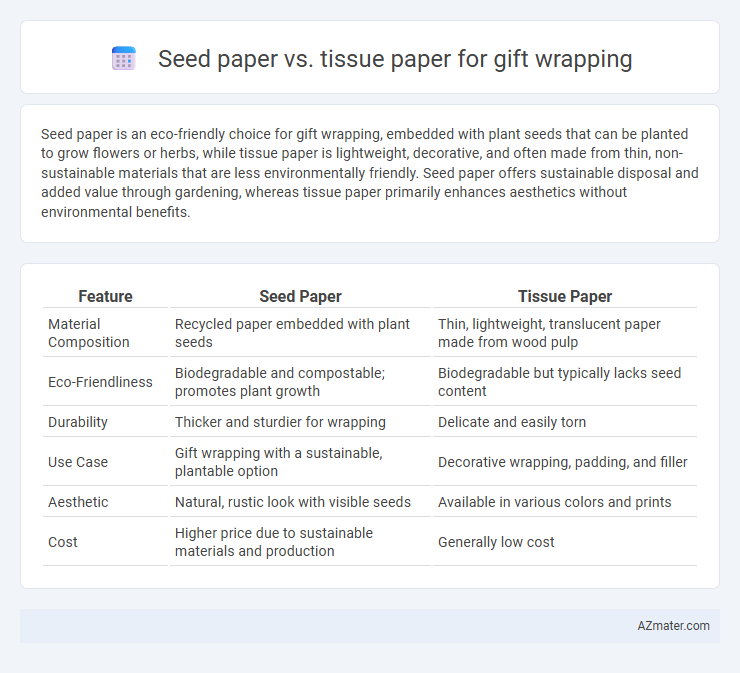Seed paper is an eco-friendly choice for gift wrapping, embedded with plant seeds that can be planted to grow flowers or herbs, while tissue paper is lightweight, decorative, and often made from thin, non-sustainable materials that are less environmentally friendly. Seed paper offers sustainable disposal and added value through gardening, whereas tissue paper primarily enhances aesthetics without environmental benefits.
Table of Comparison
| Feature | Seed Paper | Tissue Paper |
|---|---|---|
| Material Composition | Recycled paper embedded with plant seeds | Thin, lightweight, translucent paper made from wood pulp |
| Eco-Friendliness | Biodegradable and compostable; promotes plant growth | Biodegradable but typically lacks seed content |
| Durability | Thicker and sturdier for wrapping | Delicate and easily torn |
| Use Case | Gift wrapping with a sustainable, plantable option | Decorative wrapping, padding, and filler |
| Aesthetic | Natural, rustic look with visible seeds | Available in various colors and prints |
| Cost | Higher price due to sustainable materials and production | Generally low cost |
Introduction to Sustainable Gift Wrapping
Seed paper offers an eco-friendly alternative to conventional tissue paper by embedding biodegradable seeds that grow into plants after use, enhancing sustainability in gift wrapping. Unlike tissue paper, which primarily serves as decorative wrapping but often contributes to waste, seed paper combines aesthetics with environmental benefits by reducing landfill impact. Choosing seed paper supports zero-waste gifting and promotes biodiversity through its plantable properties.
What is Seed Paper?
Seed paper is an eco-friendly material embedded with plant seeds that can be planted after use, promoting sustainability and reducing waste in gift wrapping. Unlike tissue paper, which is typically single-use and often non-biodegradable, seed paper decomposes naturally while allowing the seeds to grow into flowers, herbs, or vegetables. This innovative wrapping option combines aesthetics with environmental benefits, making it an excellent choice for eco-conscious consumers.
What is Tissue Paper?
Tissue paper is a lightweight, thin, and translucent material commonly used for gift wrapping, cushioning, and decoration. Made from wood pulp or recycled fibers, it is designed to add a delicate, colorful, and soft layer around gifts, enhancing presentation while providing protection. Its breathable quality and ease of folding make tissue paper a popular choice for wrapping fragile items and creating decorative accents.
Environmental Impact: Seed Paper vs Tissue Paper
Seed paper offers a highly sustainable option for gift wrapping by being biodegradable and plantable, which helps reduce waste and promotes plant growth. Tissue paper, while often recyclable, typically requires more resources for production and may contain dyes or chemicals that hinder compostability. Choosing seed paper significantly lowers the environmental footprint by combining packaging with an eco-friendly, regenerative purpose.
Aesthetic Appeal and Customization Options
Seed paper offers a unique aesthetic appeal with its textured, eco-friendly surface embedded with wildflower seeds, creating a natural and rustic look that blooms after use. Tissue paper provides smooth, lightweight versatility with a wide range of colors and patterns, allowing for effortless customization to match any gift theme or occasion. Both options can be personalized, but seed paper adds an organic dimension that transforms gift wrapping into an interactive, sustainable experience.
Biodegradability and Waste Reduction
Seed paper significantly outperforms tissue paper in biodegradability, as it decomposes naturally and promotes waste reduction by growing into plants after use. Unlike standard tissue paper, which often ends up in landfills and contributes to waste accumulation, seed paper transforms packaging waste into a sustainable resource. Choosing seed paper for gift wrapping supports eco-friendly practices and reduces environmental impact by minimizing landfill contributions and encouraging plant growth.
Practicality and Durability During Wrapping
Seed paper offers moderate durability but requires careful handling to avoid tearing during gift wrapping, making it less practical for intricate wrapping tasks. Tissue paper is highly flexible and thin, providing ease in wrapping delicate or irregularly shaped gifts, yet it tears easily under pressure. For practical use, tissue paper excels in flexibility and smooth application, while seed paper prioritizes eco-friendliness over durability.
Cost Comparison and Availability
Seed paper typically costs more than tissue paper due to its eco-friendly materials and biodegradable properties, making it a premium choice for sustainable gift wrapping. Tissue paper is widely available in various colors and patterns at a lower price point, making it a cost-effective option for bulk wrapping needs. While seed paper availability may be limited to specialty stores or online retailers, tissue paper is readily accessible in most craft and retail outlets.
User Experience and Recipient Reactions
Seed paper offers a unique, eco-friendly gift wrapping experience that delights recipients by providing a biodegradable wrapping they can plant to grow flowers or herbs. It enhances user engagement by combining aesthetic appeal with sustainability, making the unwrapping moment memorable and meaningful. Tissue paper, while traditional and versatile, lacks the innovative impact of seed paper, often resulting in a less distinctive and environmentally conscious presentation.
Choosing the Best Eco-Friendly Option for Your Gifts
Seed paper offers a sustainable gift wrapping solution by embedding plant seeds within biodegradable material that can be planted after use, reducing waste and promoting growth. Tissue paper, while lightweight and versatile, often lacks eco-friendly properties unless specifically made from recycled fibers or certified compostable sources. Choosing seed paper supports environmental benefits through its dual function as wrapping and a planting medium, positioning it as the best eco-friendly option for gift presentation.

Infographic: Seed paper vs Tissue paper for Gift wrapping
 azmater.com
azmater.com